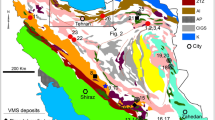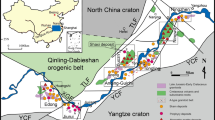Abstract
The Mendejin area is one prominent hydrothermal alteration zone in association with Paleogene volcano-sedimentary sequences in NW Iran. The volcanic sequence at Mendejin ranges in composition from basalt to andesite, dacite and rhyolite. Sulfide mineralization and related hydrothermal alteration is associated with the late Mendejin pluton that discordantly intrudes into this cogenetic volcanic sequence. The common hypogene hydrothermal alteration types observed at Mendejin include; phyllic, propylitic, carbonatization, sulfidation, silicification (veins) and argillic types with locally abundant calcite, quartz, tourmaline, sericite, chlorite, kaolinite, illite, alunite, jarosite, and gypsum. Phyllic alteration (without calcite and epidote) is paragenetically early and it is followed by propylitic alteration (with epidote and little calcite) and carbonatization (with high calcite and no epidote) reflecting a gradual increase of CO2 in the hydrothermal system. Mass balance of the hydrothermal alteration within the various volcanic rocks indicates that most elements released during alteration were locally fixed in the low-temperature hydrothermal minerals. As a result, geochemical changes are not as prominent as mineralogical transformations. There is no net mass change during phyllic, argillic, silicic vein and carbonate alteration of andesite and basalt. However, propylitic alteration and carbonatization of dacite caused net mass additions of 8% and 17%, respectively. The high-field-strength elements (HFSE) like Ti, Zr, Hf, Th, Nd, Y, La, Ce, Sm and Lu were the immobile elements during hydrothermal alteration at Mendejin. However, the rare-earth elements (REE) were mobilized during carbonate alteration. Fluid inclusions in quartz and calcite from various assemblages show that hydrothermal minerals were deposited from a low salinity (0.35 to 4.34 wt% equivalent NaCl) hydrothermal solution at 385°C to 150°C. Fluid-wall rock reactions along with boiling of hydrothermal solution and mixing of relatively saline fluid (4.34 wt% equivalent NaCl) with a low-salinity groundwater (0.35 wt% equivalent NaCl) resulted in the extensive alteration of the volcanic country rocks and precipitation of hydrothermal assemblages at Mendejin.









Similar content being viewed by others
References
Allibone A, Teasdale J, Cameron G, Etheridge M, Uttley P, Sobah A, Appiah-Kubi J, Adanu A, Arthur R, Mamphey J, Odoom B, Zuta J, Tsikata A, Pataye F, Famiyeh S, Lamb E (2002) Timing and structural controls on gold mineralization at the Bogoso gold mine, Ghana, west Africa. Econ Geol 97:949–969
Asadi HH, Voncken JHL, Hale M (1999) Invisible gold at Zarshuran, Iran. Econ Geol 94:1367–1374
Babaie HA, Ghazi AM, Babaei A, La Tour TE, Hassanipak AA (2001) Geochemistry of arc volcanic rocks of the Zagros crush zone, Neyriz, Iran. J Asian Earth Sci 19:61–76
Barrett TJ, MacLean WH (1994) Chemostratigraphy and hydrothermal alteration in exploration for VHMS deposits in greenstones and younger volcanic rocks. In: Lentz DR (ed) Alteration and alteration processes associated with Ore-Forming Systems, Geological Association of Canada, Short Course Notes 11:433–465
Beane RE, Titley SR (1981) Porphyry copper deposits, part II. Hydrothermal alteration and mineralization. In: Skinner BJ (ed) Economic geology 75th Anniversary Volume:235–69
Bence AE, Taylor BE (1985) Rare earth element systematics of west Shasta metavolcanic rocks: petrogenesis and hydrothermal alteration. Econ Geol 80:2164–2176
Brathwaite RL, Faure K (2002) The Waihi epithermal gold–silver-base metal sulfide–quartz vein system, New Zealand: temperature and salinity controls on electrum and sulfide deposition. Econ Geol 97:269–290
Cail TL, Cline JS (2001) Alteration associated with gold deposition at the Getchell Carlin-type gold deposit, north-central Nevada. Econ Geol 96:1343–1359
Christidis G (1998) Comparative study of the mobility of major and trace elements during alteration of an andesite and a rhyolite to bentonite in the islands of Milos and Kimolos, Aegean, Greece. Clays Clay Miner 46:379–399
Cox SF, Sun SS, Etheridge MA, Wall VJ, Potter TF (1995) Structural and geochemical controls on the development of turbidite-hosted gold quartz vein deposits Wattle Gully mine, Central Victoria, Australia. Econ Geol 90:1722–1746
Diakow LJ, Panteleyev A, Schroeter TG (1991) Jurassic epithermal deposits in the Toodogone river area, northern British Columbia: examples of well-preserved, volcanic-hosted precious metal mineralization. Econ Geol 86:529–554
Ellis AJ (1979) Explored geothermal systems. In: Barnes HL (ed) Geochemistry of hydrothermal ore deposits, 2nd Edn. Wiley-Interscience, NY, pp 632–683
Fournier RO (1985) The behaviors of silica in hydrothermal solutions. In: Berger BR, Bethke PM (eds) Geology and geochemistry of epithermal systems. Rev Econ Geol 2:45–59
Fuentes F, Aguirre L, Vergara M, Valdebenito L, Fonseca E (2004) Miocene fossil hydrothermal system associated with a volcanic complex in the Andes of central Chile. J Volcanol Geotherm Res 138:139–161
Golgun N (2001) Alteration and mineralization in the host rocks of the Au-bearing epithermal veins in Buzlukh and Garadash areas, Kharvana. Msc thesis. University of Tabriz, Tabriz, Iran
Grant JA (1986) The isocon diagram—a simple solution to Gresens’ equation for metasomatic alteration. Econ Geol 81:1976–1982
Gray MD, Hutchinson RW (2001) New evidence for multiple periods of gold emplacement in the Porcupine mining district, Timmins area, Ontario, Canada. Econ Geol 96:453–475
Haas JL (1971) The effect of salinity on the maximum thermal gradient of a hydrothermal system at hydrostatic pressure. Econ Geol 66:940–946
Hajalilu B (1999) Tertiary metallogeny in western Alborz-Azarbaijan (Mianeh-Siahrood) with special focuses on Hashtjin area. PhD thesis. Shahid Beheshti University, Tehran, Iran
Heald P, Foley NK, Hayba DO (1987) Comparative anatomy of volcanic-hosted epithermal deposits: acid sulfate and adularia-sericite types. Econ Geol 82:1–26
Heinrich CA (2005) The physical and chemical evolution of low-salinity magmatic fluids at the porphyry to epithermal transition: a thermodynamic study. Miner Depos 39:864–889
Hezarkhani A, Williams-Jones AE (1998) Controls of alteration and mineralization in the Sungun porphyry copper deposit, Iran: evidence from fluid inclusions and stable isotopes. Econ Geol 93:651–670
Humphris SE (1984) The mobility of rare earth elements in the crust. In: Henderson P (ed) Geochemistry of rare earth elements. Amsterdam, Elsevier, pp 317–342
Huston DL, Blewett RS, Keillor B, Standing J, Smithies RH, Marshall A, Mernagh TP, Kampard J (2002) Lode gold and epithermal deposits of the Mallina Basin, north Pilbara Terrain, Western Australia. Econ Geol 97:801–818
Jenner GA (1996) Trace element geochemistry of igneous rocks: geochemical nomenclature and analytical geochemistry. In: Wyman DA (ed) Trace element geochemistry of volcanic rocks: applications for massive sulfide exploration. Geological Association of Canada, Short Course Notes 12:51–77
Karimzadeh Somarin A (2004a) Evolution of the Mendejin calc-alkaline plutonic rocks, NW Iran, and behavior of gold in the magma. Geophysical Research Abstracts 6, 1287. European Geoscience Union, France, 2004
Karimzadeh Somarin A (2004b) Mineralogy and geochemistry of hydrothermal alteration in the Mendejin Au prospect, NW Iran. Geophysical Research Abstracts 6, 1290. European Geoscience Union, France, 2004
Karimzadeh Somarin A (2005) Petrology and geochemistry of Early Tertiary volcanism of the Mendejin area, Iran, and implications for magma genesis and tectonomagmatic setting. Geodin Acta 18:343–362
Karimzadeh Somarin A (2006) Geology and geochemistry of the Mendejin plutonic rocks, Mianeh, Iran. Asian J Earth Sci 27, 819–834
Karimzadeh Somarin A, Moayyed M (2002) Granite- and gabbrodiorite-associated skarn deposits of NW Iran. Ore Geol Rev 20:127–138
Karimzadeh Somarin A, Ashley P (2004) Hydrothermal alteration and mineralization of the Glen Eden Mo-W-Sn deposit: a leucogranite-related hydrothermal system, Southern New England Orogen, NSW, Australia. Miner Depos 39:282–300
Karimzadeh Somarin A, Nokhodchi N (2004) Mineralogy, geochemistry, alteration and genesis of the Sheikhdar Abad Cu deposit, Mianeh, NW Iran. Geophysical Research Abstracts 6, 1292. European Geoscience Union, France, 2004
Klatt H (2000) A new Carlin trend in Iran. InfoMine’s NewsMine. Robertson Info-data Inc
Kuehn CA, Rose AW (1992) Geology and geochemistry of wall-rock alteration at the Carlin gold deposit, Nevada. Econ Geol 87:1697–1722
Leitch CHB, Lentz DR (1994) The Gresen’s approach to mass balance constraints of alteration systems: methods, pitfalls, examples. In: Lentz DR (ed) Alteration and Alteration Processes Associated with Ore-forming Systems. Geological Association of Canada, Short Course Notes 11:161–192
Lentz DR (1996) Trace-element systematics of felsic volcanic rocks associated with massive sulphide deposits in the Bathurst Mining Camp: petrogenetic, tectonic and chemostratigraphic implications for VMS exploration. In: Wyman DA (ed) Trace element geochemistry of volcanic rocks: applications for massive sulfide exploration. Geological Association of Canada, Short Course Notes 12:359–402
LeMaitre RW (ed) (2002) Igneous Rocks: A Classification of Igneous Rocks and Glossary of Terms. Recommendations of the International Union of Geological Sciences Subcommision on the Systematics of Igneous Rocks. Cambridge University Press, UK
Love DA, Roberts RG (1991) The geology and geochemistry of gold mineralization and associated alteration at the Rundle gold deposit, Abitibi Subprovince, Ontario. Econ Geol 86:644–666
Lowenstern JB (2001) Carbon dioxide in magmas and implications for hydrothermal systems. Miner Depos 36:490–502
MacLean WH (1990) Mass change calculations in altered rock series. Miner Depos 25:44–49
MacLean WH, Barrett TJ (1993) Lithogeochemical techniques using immobile elements. J Geochem Explor 48:109–133
Mohajjel M, Fergusson CL (2000) Dextral transpression in Late Cretaceous continental collision, Sanandaj-Sirjan zone, western Iran. J Struct Geol 22:1125–1139
Muntean JL, Einaudi M (2000) Porphyry gold deposits of the Refugio district, Maricunga Belt, Northern Chile. Econ Geol 95:1445–1472
Nabavi MH (1976) An introduction to the geology of Iran. Geological Survey of Iran, 109 p (in Persian)
Nesbitt BE, Murowchick JB, Muehlenbachs K (1986) Dual origin of lode gold deposits in the Canadian Cordillera. Geology 14:500–509
Palin JM, Xu Y (2000) Gilt by association? origins of pyritic gold ores in the Victory mesothermal gold deposit, Western Australia. Econ Geol 95:1627–1634
Roedder E (1971) Fluid inclusion studies on the porphyry-type ore deposits at Bingham, Utah, Butte, Montana, and Climax, Colorado. Econ Geol 66:98–120
Roedder E (1984) Fluid inclusions. Min Soc Am, Rev Miner 12:644
Shelton KL, So CS, Haeusler GT, Chi SJ, Lee KY (1990) Geochemical studies of the meteoric water dominance in a Te-bearing epithermal system. Econ Geol 85:1114–1132
Simpson MP, Mauk JL, Simmons AF (2001) Hydrothermal alteration and hydrologic evolution of the Golden Cross epithermal Au-Ag deposit, New Zealand. Econ Geol 96:773–796
Sverjensky DA (1984) Europium redox equilibria in aqueous solution. Earth Planet Sci Lett 67:70–78
Uemoto T, Ridley J, Mikucki E, Groves DI, Kusakabe M (2002) Fluid chemical evolution as a factor in controlling the distribution of gold at the Archean Golden Crown lode gold deposit, Murchison Province, Western Australia. Econ Geol 97:1227–1248
Vikre PG (1989) Ledge formation at the Sandstorm and Kendall gold mines, Goldfield, Nevada. Econ Geol 84:2115–2138
Wilkinson JJ (2001) Fluid inclusions in hydrothermal ore deposits. Lithos 55:229–272
Winchester JA, Floyd PA (1977) Geochemical discrimination of different magma series and their differentiation products using immobile elements. Chem Geol 20:325–343
Acknowledgements
This contribution is based on field and laboratory studies carried out at the University of Tabriz, Iran, and University of New Brunswick, Canada. This project was funded by Research Office at the University of Tabriz. The microprobe analyses were financially supported by a Discovery NSERC grant to DL. AKS wishes to acknowledge the generous support from staff of this office. N. Mosaiebzadeh is thanked for technical assistance. Dr. Doug C. Hall is also acknowledged for microprobe analyses. Dr. R. Abart and an anonymous referee are thanked for very helpful and constructive comments.
Author information
Authors and Affiliations
Corresponding author
Additional information
Editorial handling: R. Abart
Rights and permissions
About this article
Cite this article
Karimzadeh Somarin, A., Lentz, D.R. Mineralogy, geochemistry and fluid evolution of a fossil hydrothermal system in the Paleogene Mendejin volcanic sequence, East Azarbaijan, Iran. Miner Petrol 94, 123–143 (2008). https://doi.org/10.1007/s00710-008-0008-3
Received:
Accepted:
Published:
Issue Date:
DOI: https://doi.org/10.1007/s00710-008-0008-3




